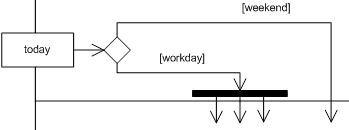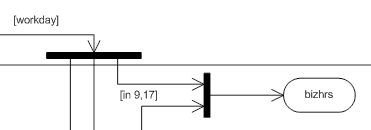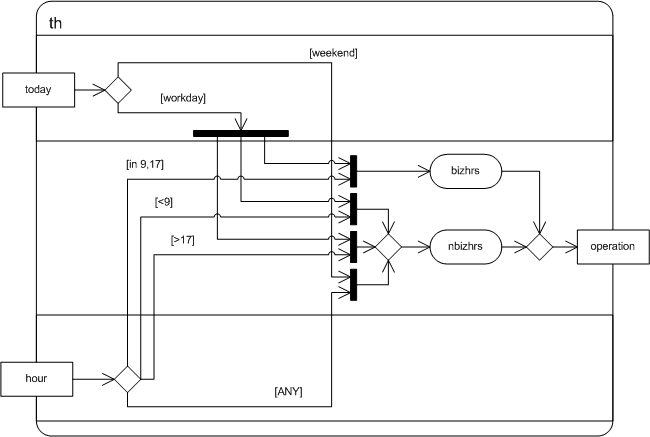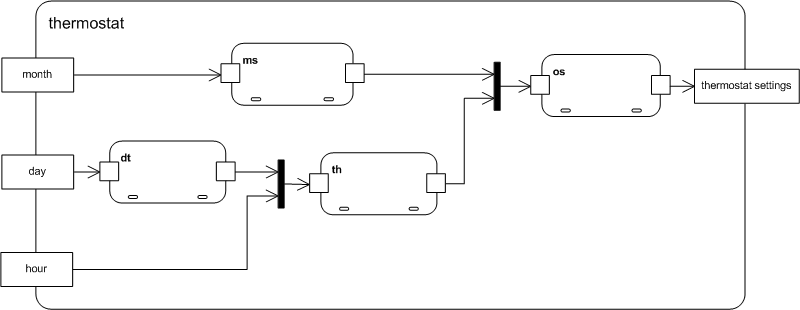Table of Contents
Visual Business Rules and Process Modeling
Krzysztof Kluza kluza@agh.edu.pl, Grzegorz J. Nalepa gjn@agh.edu.pl
Outline
- Intro
- Basics
- UML
- MOF
- OCL
- Challenges
- Rules in UML
- URML
- PRR
- BPMN & BR
- HeKatE
- ARD & XTT rep
- metamodel
- future work
Introduction
- abstract level of design
- visual modeling → this is not obvious! see Literate_programming
- programming paradigms → different design paradigms
- knowledge vs. software engineering
- declarative vs. procedural, etc.
UML Trajectory
Unified Modeling Language (UML) Today
- general-purpose modeling language in the field of software engineering,
- 13 types of diagrams,
- includes a set of graphical notation techniques to create abstract models of specific systems.
The Meta-Object Facility (MOF)
- model - representation of something, constructed and used for a particular purpose,
- the meaning of the model is related to the situation and context wherein the model is used,
- metamodel - a model that represents a modeling language,
- MOF
- an OMG standard for model-driven engineering,
- designed as a four-layered architecture,
- UML & OCL are defined in MOF.
MOF Layers
The Object Constraint Language (OCL)
- language
- declarative language for describing rules that apply to UML models,
- a constraint language (OCL 1.4)
- + general object query language (OCL 2.0)
- part of OMG UML standard (may be used with any MOF),
- makes a Meta-Object Facility model more precise,
- example:
The academic grade of a persons supervisor must be greater than the academic grade of the supervised person.
context Person inv: self.supervisor.grade.value > self.grade.value
Selected challenges
- UML/MOF → lang + metalang level. universal

- if MOF is a universal metalang, what about EBNF
- suitability for process modeling
- suitability for knowledge modeling with rules
Grammars vs MOF
- approaches in publications:
- grammar visualization (mapping)
- metamodel optimalization (semi-automatic)
- after auto generation
- before auto generation
Grammar2MOF example
program: (vardefinition | assignment)* vardefinition: type IDENT !SEMICOLON type: (INT | FLOAT) assignment: IDENT !BECOMES expression !SEMICOLON expression: (IDENT | NUMBER) (PLUS expression)?
a UML-Based Rule Modeling Language (URML)
- developed by the REWERSE Working Group I1,
- allows visual rule modeling based on UML class models,
- Strelka – a tool for making graphical URML models.
URML examples (DR)
URML examples (PR)
If the reservation date of a rental is 5 days before the start date of a rental, then grant the rental a discount of 10.
URML summary
- extends UML class diagrams,
- single rules,
- non-standard → tool support ( Strelka - plugin for Fujaba),
- rules serialized to R2ML,
- in the future translations: R2ML ↔ OCL and R2ML↔OWL/SWRL
The Production Rule Representation (PRR) [specification Beta 1]
A production rule is a statement of programming logic that specifies the execution of one or more actions in the case that its conditions are satisfied.
- PRR should improve the modeling of production rules, especially with respect to UML,
- PRR should allow interoperability across different vendors providing production rule implementations.
The production rule is typically represented as:
if [condition-list] then [action-list]
Example of PRR from specification Beta 1:
- English text: If there is no CD item in the customer shopping cart then add a hyperlink to the CD page in the customer web page.
- Proprietary rule language:
rule noCDItem {
when {
?customer1: Customer();
?shoppingCart1: ShoppingCart(customer == ?customer1);
not Item(type == ItemType.CD ; shoppingCart == ?shoppingCart1);
} then {
modify ?customer1{ hyperlinkToCD = true; }
}
}
- PRR OCL:
Rule noCDItem ruleVariable: ?customer: Customer = Customer->any() ?sCart: ShoppingCart = ShoppingCart->any(c:customer|c=?customer) ?cdItems: Set = ?sCart.items->select(e:items|e.type=ItemType.CD) Condition: ?cdItems.isEmpty() Action: ?customer.hyperlinkToCD = true
PRR Summary
- no common agreement about the syntax of PRR,
- different syntaxes, but common metamodel ⇒ translation between different syntaxes,
- no defined PRR syntax ⇒ can be URML.
The Business Process Modeling Notation (BPMN)
- a graphical notation for specifying business processes in a Business Process Diagram (BPD),
- is intuitive to business users and able to represent complex process semantics,
- provides a mapping between the graphics of the notation to the underlying constructs of execution languages, particularly Business Process Execution Language.
Example of elements
Example of usage BPMN
BMPN summary
- notation dedicated for business org (semantic for business org),
- only one diagram BPD, but many artifacts → allows specify even complex processes,
- formal notation → simulation, optimalization & error detection,
- automatic generation of BPEL4WS code,
- lack of security support for data structure, users hierarchy and access to data.
Business rules
- describe the operations, definitions and constraints that apply to an organization in achieving its goals,
- four categories of BR according to Business Rules Group:
- definitions of business terms,
- facts relating terms to each other,
- constraints,
- derivations.
BR Example
Example of detailed business rule
The description defines the rule exactly (text, flow charts, UML activity diagrams, OCL, ILOG rules language, BRML…).
BR representation
- UML model
- OCL – a formal language used to describe expressions on models eg. constraint:
The lower bound must be a non-negative integer literal.
lowerBound()->notEmpty() implies lowerBound() >= 0
- many dedicated approaches like presented URML, PRR…
UServ
UServ Financial Services case study:
- a benchmark case study from the Business Rules Forum,
- provides a full service portfolio of financial products of Insurance Company,
- contains many business rules and Business Process Models,
- more: hekate_case_userv.
UServ BR in URML
Example for Eligibility Business Rules / Automobile Eligibility / Potential Theft Category eg.
- If all of the following are true, then the car's potential theft rating is moderate:
- car's price is between $20,000 and $45,000,
- car model is not on the list of “High Theft Probability Auto”.
UServ Business Rules
UServ Business Process Model
HeKatE
Our goals/tasks
- ARD & XTT representation in UML,
- ARD & XTT rules on UML diagrams presentation,
- integration of software & knowledge engineering methods.
ARD
Proposed model of ARD is based on component diagrams. ARD contains diferent kind of UML dependencies such as:
- «derive» specifies a derivation relationship among model elements, where one of them can be computed from the another,
- «refine» specifies a refinement relationship among model elements at different levels of development; refinement can be used to model transformation from one to another phase of a sequential model development,
- «trace» specifies a trace relationship among model elements represents the same concept in different models; it is mainly used for tracking changes across models.
ARD example (1)
Example of ARD diagram:
<graphviz file=“hekate:therm-a8.dot”></graphviz>
ARD example (2)
TPH
XTT
Proposed model of XTT is based on activity diagrams, which are related to flow diagrams and can illustrate the activities taking place in the system.
- Outline of XTT2UML translation algorithm (on the example of thermostat).
Algorithm step 1
All input attributes become input parameters and output attribute becomes output parameter of an activity
(for the sake of transparency the diagram can be divided into partitions with a swimlane).
Algorithm step 2
For each attribute (activity parameter), if there is more than one unique value in the XTT add a decision node
and for every unique value of attribute needs to be added:
- the control flow with guard condition (with that unique value),
- if the value occurs frequently, the flow is finished with a fork node with number of outputs equal to the number of times the value appears in XTT table.
Algorithm step 3
For each rule (a row in XTT) draw a join node with the number of inputs equal to the number of input parameters and one output. For each join node:
- inputs are connected using an adequate flow (in accordance with the values of attributes in the rule),
- outputs are connected (using a flow) with the action having a value corresponding to the output attribute in the rule:
- directly, if the value of attribute occurred in XTT only once,
- otherwise through a merge node.
Algorithm step 4
Outputs of all actions are merged in a merge node and a flow is lead to output parameter of activity.
XTT th table representation example
Thermostat Case
Evaluation
Proposed representation:
- shows both structure of dependecies in ARD and process of rules processing in XTT,
- doesn't extend UML diagrams (like URML),
- allows serialization to XMI.
Future work
- metamodel,
- XSTL translators,
- tools for verifing models with metamodel,
- work in progress…
Thank you
Questions…





































